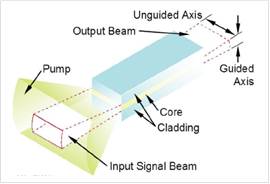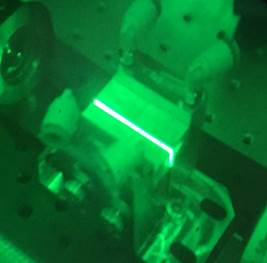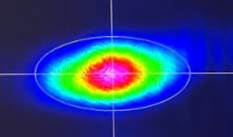Planar Waveguide Modules
Aqwest is developing planar waveguide (PWG) for high-average power operation at 1 and 2 micron wavelengths. PWG uses a thin ribbon-like LGM (aka "core") in which the signal beam and the pump co-propagate in the ribbon plane
This arrangement provides a long path for pump absorption and signal amplification. In the thin direction of the PWG (parallel to the temperature gradient), the signal and pump beams are guided by total internal reflection as in a fiber. In the wider direction the beams are collimated by the injection optics. The pump may be injected into one or both PWG ends and aligned with the signal. The large faces of the ribbon provide an ample surface area for efficient cooling. Due to the small (200 to 400 µm) thickness of the ribbon, the LGM operates essentially at the temperature of the heat sink to which it is attached, thus avoiding significant thermo-optical effects and thermo-mechanical stresses. PWG has a small volume, which translates to modest (~ 1 Joule-level) stored energy. Key advantages of PWG include high-average power operation with good beam quality and compact packaging.
The development of PWG-based amplifiers at Aqwest is supported by the US Navy, USMC, and the US DOE.



References
- Filgas, T. Clatterbuck, M. Cashen, A. Daniele, S. Hughes, and D Mordaunt, ” Recent Results for the Raytheon RELI Program,” SPIE Vol. 8381, 2012
- Raytheon Technology Today 2008: Next-generation lasers for advanced AO systems,” www.raytheon.com
- Mordaunt and D. Filgas, “Raytheon RELI program progress,” Public press release, 2013, www.raytheon.com
- Filgas, J. Vetrovec, D. Copeland, C. Smith, and E. Briscoe, ” Spectral Gain and 2-Micron Lasing in Tm:Lu2O3 Ceramic under Intense Pumping,” SPIE vol. 10896-4, 2019
Copyright © Aqwest, LLC all rights reserved.
